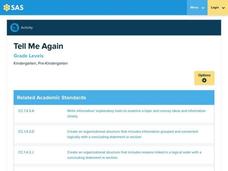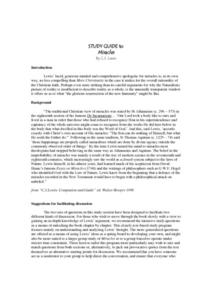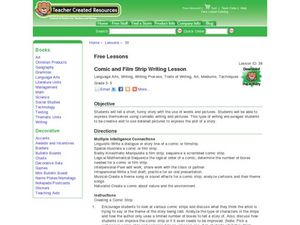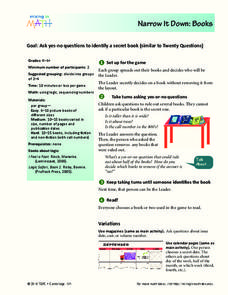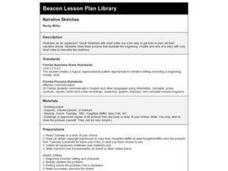Savvas Learning
Putting Shapes in Order
Challenge math scholars with polygon word problems that require logical reasoning. They answer two word problems about geometric shapes and their arrangement in a column based on clues given. Next, learners draw a robot made of...
For the Teachers
Story Strips Sequencing
What happens next? Work on story sequence with a lesson that prompts kids to put a story back in order. Additionally, they discuss what would happen if one event was missing from the sequence.
Pennsylvania Department of Education
Tell Me Again
Students demonstrate how to retell a story in sequential order. In this reading comprehension lesson, students listen to a suggested read aloud, such as Little Boy Blue. Additionally, students practice retelling the story by using...
C.S. Lewis Foundation
Study Guide to Miracles
Teaching is challenging, so is proving through logic that miracles and divine intervention can happen in this world. It is even more arduous to teach the text of that proposition—good thing there are resources available, like this study...
Curated OER
Problem Solving: Draw a Diagram
This problem solving PowerPoint presents a detailed, logical sequence of steps to follow in order to solve a story problem. The thinking processes described are given in text and represented by a visual model. After discussing the...
Curated OER
Activity Plan 4-5: Riddles by the Bagful!
Students write a riddle to be included in a class riddle book. In this creative-thinking lesson, the teacher will introduce children to riddles, then guide children through the process of writing and illustrating their own riddles to be...
Curated OER
The Beginning, The Middle, & The End
Cut magazine pictures into three sections, having your youngsters piece the pictures back together. With this fun activity, they discover the importance of sequencing a story. Then they use a fun template (shaped like a burger) to write...
Scholastic
Persausive Writing
A unit on persuasive writing guides elementary learners through the writing process. The first part examines the elements of persuasive writing, including expressing an opinion, connecting ideas, using supporting facts, and writing...
Curated OER
Sorting
Students examine the concepts of organization and classification. In this library skills lesson, students practice ordering and sorting skills by playing an interactive Internet game. Students then practice their classification skills in...
Curated OER
Sorting
Students examine the concept of organization. In this library skills lesson, students practice ordering and sorting skills by playing the Flood Game.
Curated OER
Alphabet Sideshow
Students practice sound and recognition of letters in alphabetical sequence. They gain an understanding of letter sounds and order. They create a slide show with graphics and text. They present their slide show to the class.
Curated OER
Hop Into A Story
Students listen to the story "Tuesday," and discuss all of the elements that made this story. In this language instructional activity, students tell the story of "Tuesday," (which is all pictures, no words), as the teacher turns the...
Curated OER
Drafting
Students use transitions to connect the beginning, middle and end of their writing. In this lesson on drafting a story, students use a graphic organizer sandwich to put pictures back together and recognize a specific order.
Curated OER
Explore Chapters 1 - 5
Students preview the novel, "Dragonwings," by Laurence Yep, make connections between the novel previewed and their prior knowledge, other texts, and the world. They utilize graphic representations including charts, graphs, pictures, and...
Curated OER
Zero is Our Hero
Students practice counting sets of items by 10's. In this counting lesson, students create flash cards that show a zero while hiding the first number in order for students to practice counting by 10's. Students practice...
Curated OER
Something From Nothing
Students listen to story Joseph Had A Little Overcoat to explore people from another culture and how one item can be used to make other items; students use scraps of fabric and other knickknacks to create pictures or toys.
Curated OER
Comic and Film Strip Writing
Students write a funny story and illustrate it in a comic strip. In this comic strip lesson, students study comic strips and determine the plot of each story. Students then write a short story and illustrate it using a comic strip...
Curated OER
Narrow It Down: Books
Students ask yes-no questions to identify a secret book. In this asking questions lesson plan, students ask yes or no questions about books to identify a secret book. Students identify the book and then read one of the example books.
Curated OER
Narrative Sketches
Second graders read "Tuesday" for inspiration. They draw three pictures that illustrate the beginning, middle and end of a story with very short notes to describe the sketches. They use the sketches as an organizer to use before writing...
Curated OER
Mother's Day Flowers
Students complete a circle map describing why they love their mom and use a flower template to type the ways. Then they insert a digital picture into the center of the flower. The flowers are then printed out and given to their mothers...
Curated OER
Narrative Writing
Students complete activities to learn narrative writing. In this narrative writing lesson plan students are given writing prompts in order to better understand how to write in a narrative format.
Curated OER
A Visit to the Rain Forest
First graders preview "The Great Kapok Tree" by discussing the cover and the tree. They read the book and acknowledge the animals. They play a sequencing game in groups to identify the order the animals appeared in the book.
Curated OER
Making a Family Newsletter: Using a Word Template
Students create a one-page family newsletter about a selected person in their family. They bring in a photo or use a digital camera to take a picture of their selected family member, and use a newsletter template to write and publish...
Curated OER
Sunrise Sequencing
Students examine sequencing events by discussing what they do each morning. They complete a four-panel sequence of events assignment, drawing a picture and writing a sentence for each box in the panel.


